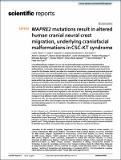Por favor, use este identificador para citar o enlazar a este item:
http://hdl.handle.net/10261/268074COMPARTIR / EXPORTAR:
 SHARE SHARE
 CORE
BASE CORE
BASE
|
|
| Visualizar otros formatos: MARC | Dublin Core | RDF | ORE | MODS | METS | DIDL | DATACITE | |

| Título: | MAPRE2 mutations result in altered human cranial neural crest migration, underlying craniofacial malformations in CSC-KT syndrome |
Autor: | Thues, Cedric; Valadas, Jorge S.; Deaulmerie, Liesbeth; Geens, Ann; Chouhan, Amit K.; Duran-Romaña, Ramón; Schymkowitz, Joost; Rousseau, Frederic; Bartusel, Michaela; Rehimi, Rizwan; Rada-Iglesias, Alvaro CSIC ORCID; Verstreken, Patrik; Van Esch, Hilde | Palabras clave: | Developmental biology Genetics Medical research Stem cells |
Fecha de publicación: | 2021 | Editor: | Springer Nature | Citación: | Scientific Reports 11: 4976 (2021) | Resumen: | Circumferential skin creases (CSC-KT) is a rare polymalformative syndrome characterised by intellectual disability associated with skin creases on the limbs, and very characteristic craniofacial malformations. Previously, heterozygous and homozygous mutations in MAPRE2 were found to be causal for this disease. MAPRE2 encodes for a member of evolutionary conserved microtubule plus end tracking proteins, the end binding (EB) family. Unlike MAPRE1 and MAPRE3, MAPRE2 is not required for the persistent growth and stabilization of microtubules, but plays a role in other cellular processes such as mitotic progression and regulation of cell adhesion. The mutations identified in MAPRE2 all reside within the calponin homology domain, responsible to track and interact with the plus-end tip of growing microtubules, and previous data showed that altered dosage of MAPRE2 resulted in abnormal branchial arch patterning in zebrafish. In this study, we developed patient derived induced pluripotent stem cell lines for MAPRE2, together with isogenic controls, using CRISPR/Cas9 technology, and differentiated them towards neural crest cells with cranial identity. We show that changes in MAPRE2 lead to alterations in neural crest migration in vitro but also in vivo, following xenotransplantation of neural crest progenitors into developing chicken embryos. In addition, we provide evidence that changes in focal adhesion might underlie the altered cell motility of the MAPRE2 mutant cranial neural crest cells. Our data provide evidence that MAPRE2 is involved in cellular migration of cranial neural crest and offers critical insights into the mechanism underlying the craniofacial dysmorphisms and cleft palate present in CSC-KT patients. This adds the CSC-KT disorder to the growing list of neurocristopathies. | Versión del editor: | http://dx.doi.org/10.1038/s41598-021-83771-3 | URI: | http://hdl.handle.net/10261/268074 | DOI: | 10.1038/s41598-021-83771-3 | E-ISSN: | 2045-2322 |
| Aparece en las colecciones: | (IBBTEC) Artículos |
Ficheros en este ítem:
| Fichero | Descripción | Tamaño | Formato | |
|---|---|---|---|---|
| MAPRE2_mutations _Thues_PV_Art2021.pdf | 3,68 MB | Adobe PDF |  Visualizar/Abrir |
CORE Recommender
PubMed Central
Citations
6
checked on 12-may-2024
SCOPUSTM
Citations
7
checked on 15-may-2024
WEB OF SCIENCETM
Citations
6
checked on 27-feb-2024
Page view(s)
42
checked on 17-may-2024
Download(s)
35
checked on 17-may-2024

